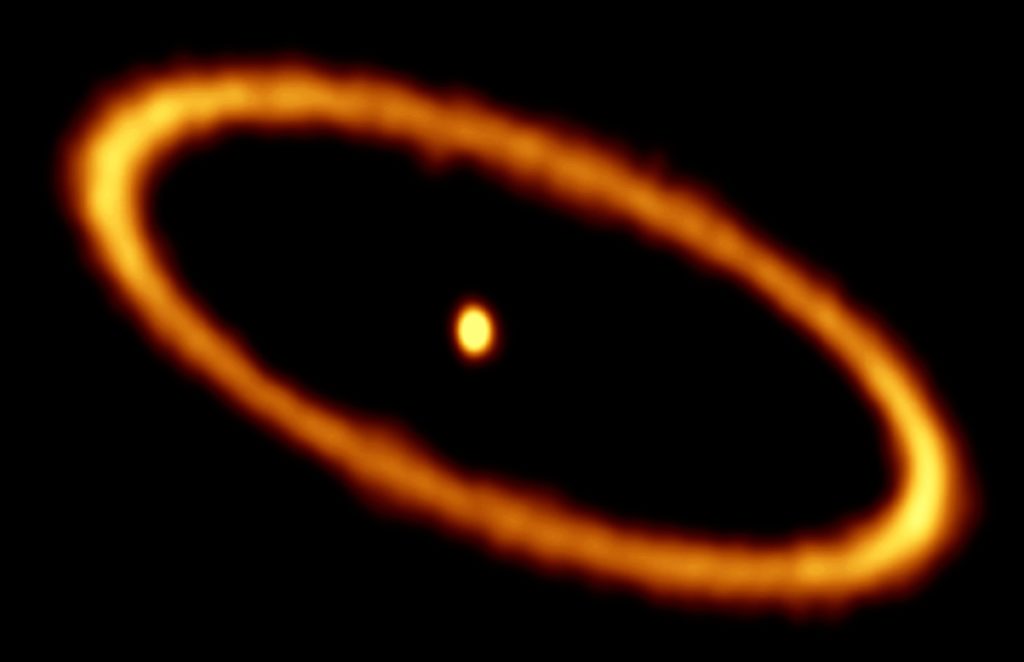
In the vast expanse of sky between the brilliant stars Antares in the west and Sirius in the east, there lies but a single bright star of note, the star Fomalhaut. Low and prominent over the southern horizon, this lovely white star is a lonely sight on a northern fall evening. Fomalhaut marks the mouth of the constellation Piscis Austrinus (the Southern Fish). The star is a pretty enough sight for casual stargazers this time of year, and it offers a very widely spaced companion that’s easy to see in binoculars. The star also hosts at least one ring of glowing dust and debris left over from its birth. And where there’s dust, there may very well be planets…

Because, for northern observers, Fomalhaut has no other bright stars nearby, it’s sometimes called the “lonely star of autumn”. It’s the brightest star in the vast expanse of sky between Deneb and Aldebaran, and between Antares and Sirius. In the southern hemisphere, the star lies nearly overhead in spring, along with the somewhat brighter star Achernar to the southeast to keep it company from a respectful distance.
Fomalhaut (pronounced “FOAM-a-lot” or “FOAM-a-low”) is a young A-type main sequence star, perhaps 100-300 million years old, and it’s just settling down to a long billion-year life span. Physically, it’s much like the more famous star Vega, and at a distance of 25 light years, about the same distance away. In fact, astronomers have determined Fomalhaut is physically associated with Vega in the constellation Lyra and the star Castor in the constellation Gemini. They are among a group of some 16 stars of the Castor Moving Group, stars that may have originated in the same star cluster, been kicked out of the cluster by a gravitational interaction, and now move through space together but unbound.

Fomalhaut is an unremarkable sight in a small telescope. But in space-based scopes wielded by professional astronomers, it’s a different story. In 1983, using the IRAS satellite, astronomers detected a surplus of infrared light coming from Fomalhaut. This suggested the star was surrounded by a torus of dust heated by the star itself.
And where there’s dust around a new star, there may be planets. So astronomers looked closer. And in 2008, in an astonishing feat of observational astronomy, a team using the Hubble Space Telescope directly imaged a planet buried in the dusty disk around Fomalhaut. Or did they? There’s been much debate about whether this is a true planet or simply a dense cloud of debris in the process of forming a planet. If it is a planet, it is no Earth. Fomalhaut b, as it’s called, is bigger than Neptune and no more than three times the mass of Jupiter. And it’s far from the main star, about 115 astronomical units, which means the planet takes 875 years to revolve around Fomalhaut. It is also extremely cold and embedded in a field of debris.
To make matters more interesting, additional observations by the remarkable ALMA observatory in northern Chile suggest there are two planets in the Fomalhaut system. Much science remains to be sorted out in this fascinating stellar system.
You won’t see planets or dust rings around Fomalhaut in any backyard telescope. But as you now know, there is much going on around this pure white first-magnitude star flickering above the southern horizon. It is also the third-brightest star in the heavens, after the Sun and Pollux, which are known to have exoplanets.

If you’re up for it, look for the companion star to Fomalhaut, a smaller and fainter star known as Fomalhaut B or TW Piscis Austrinus. This variable star is (just barely) gravitationally bound to its bigger companion at a distance of 0.91 light years. From our point of view, that puts it about 2º south of Fomalhaut. This yellow-orange star shines at magnitude 6.5, so you need binoculars or a telescope to spot it right next to a slightly brighter unrelated star SAO 214187. Fomalhaut has another companion, a dim-bulb 13th-magnitude red dwarf star about 5.7° to the north. In real terms, C is about 2.5 light years from Fomalhaut itself, but amazingly the stars are still isolated enough in their place in the Milky Way to remain gravitationally bound despite their great separation. Lonely stars indeed.
Share This: